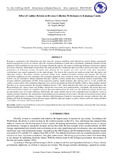Effect of Cashless Reform on Revenue Collection Performance in Kakamega County
Date
2023-08-20Author
Mukhwaya, Aberton Okoth
Ngala, Consolata
Mungai, Angela
Metadata
Show full item recordAbstract
Revenue is considered a key element for any state since the resources mobilized and collected are used to finance government projects and provide services to citizens. After the creation of Kakamega County due to devolution, Kakamega initiated revenue reforms in 2019 to mobilize its own source of revenue. Despite the reforms, the county is still facing challenges and massive deficits in revenue collection, which hinder its operation. The study specifically examined the effect of cashless reform on revenue collection performance in Kakamega County. Secondary data between the two periods was used, and the study chose descriptive, correlational, and causal comparative as the study designs. The data in this research was analyzed using both descriptive and inferential statistics. Descriptive statistics measured include mean, standard deviation, minima, and maxima. The Pearson correlation coefficient was also calculated. Pre-estimation diagnostic tests carried out in the study included unit root and Philip Perron tests for stationarity. Results indicated that after reforms, cashless reform had a moderately positive relationship with revenue collection performance (0.450). From regression analysis, model estimates after reforms were (t = 2.81, p<0.05) for cashless system reform. Post-estimation diagnostic tests carried out include the Breusch-Godfrey LM test, whose findings showed that there is no autocorrelation; the Variance Inflation Factors (VIF), which indicated that there was no multicollinearity; the Breusch-Pagan test, whose results and findings showed the error terms were homoscedastic; and finally, the Jarque-Bera test, which showed that residuals are regularly conveyed. Recommendations from the study were that Kakamega County should come up with modern ways of revenue collection. Additionally, the county should come up with a simplified and cost-effective system to enhance revenue collection. The study further recommended severe sanctions on tax evaders. The discoveries from research will be utilized by policymakers to enhance revenue collection within Kakamega County by increasing the revenues collected. Also, the findings will help the Kakamega County Revenue Agency (KCRA) staff gain insights on policy reforms within the county and their causal effect on revenue collection performance.
URI
https://ajernet.net/ojs/index.php/ajernet/article/view/103https://doi.org/10.51867/ajernet.4.2.26
http://ir-library.mmust.ac.ke:8080/xmlui/handle/123456789/2287
Collections
- Gold Collection [1005]

